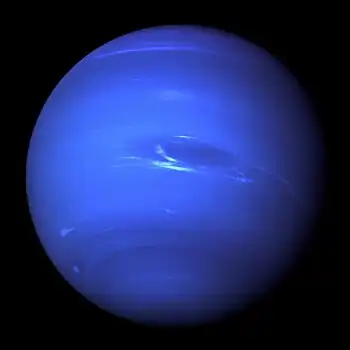
Neptune is the eighth and farthest planet from the Sun in the Solar System. It is the fourth largest planet by diameter, and the third largest by mass. The planet is named after the Roman god of the sea. Discovered on September 23, 1846, Neptune was the first planet found by mathematical prediction rather than regular observation. Unexpected changes in the orbit of Uranus led astronomers to deduce the gravitational perturbation of an unknown planet. Neptune was found within a degree of the predicted position. The moon Triton was found shortly thereafter, but none of the planet's other 12 moons were discovered before the 20th century. Neptune has been visited by only one spacecraft, Voyager 2, which flew by the planet on August 25, 1989. Neptune is similar in composition to Uranus, and both have different compositions from those of the larger gas giants Jupiter and Saturn. Traces of methane in the atmosphere, in part, account for the planet's blue appearance. At the time of the 1989 Voyager 2 flyby, its southern hemisphere possessed a Great Dark Spot comparable to the Great Red Spot on Jupiter. Neptune has a faint and fragmented ring system, which may have been detected during the 1960s but was only indisputably confirmed by Voyager 2. (Full article...)